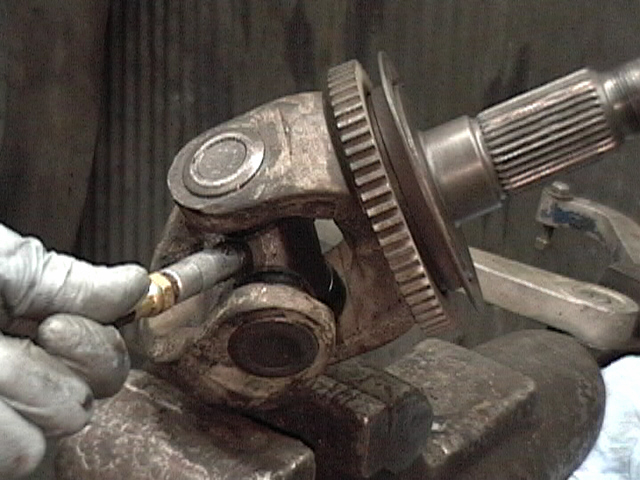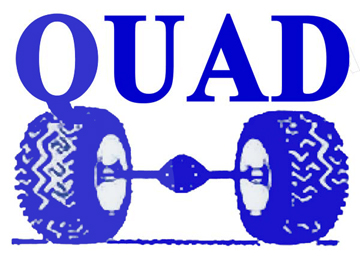|
The 4x4 front
drive axle and attached components have always required a
substantial amount of preventative maintenance to remain in peak
operating condition. Periodic front axle maintenance and
attention to detail can greatly extend the service life of your
Dodge 4x4 and minimize the chances of a catastrophic component
failure.
The goal in
practicing preventative maintenance (PM) is to achieve maximum
safe
service life of a vehicle and it’s components. With a PM
program, service is on a schedule and the predictable costs can
be prepared for. Admittedly, there is a significant cost to good maintenance, but in the long run it is far cheaper than
having parts fail at the worst possible time.
Individual
replacement parts and comprehensive rebuild/renew kits with, and
without, special tools are readily available. For lubricants,
aftermarket alternatives meeting Mopar specifications are easily
found. In our shop, we now use only synthetic greases on
chassis components and synthetic gear lubes in most front
differentials.
Wheel Bearings
The
unitized wheel bearing/hub assembly is not serviceable and must
be replaced as an assembly. Compared to first generation
trucks, the new hub design offers increased service life, but at
a much higher replacement cost. We often work on ranch and
contractor trucks with loose or failed front wheel bearings
starting around 85,000 miles. In contrast, bearings in what we
call “town trucks” may last well over 150,000 miles. Since the
bearing and hub is a unitized set, little preventative
maintenance can be done except checking for loose wheel bearings
at every tire rotation.

Checking for loose
wheel bearings on 1997 W3500
|
Any wheel
that is cracked, bent, or has worn lug nut holes should be
replaced. Proper tightening of the lug nuts in a criss-cross
pattern, with a torque wrench to the specified torque is
absolutely critical to the safe operation of your Dodge. Two
piece, dual wheel lug nuts should be cleaned and lubricated with
two drops of oil at the interface of the hex nut and washer
every time the tires are rotated. Wheel nuts should be
retorqued to specification after 100 and 500 miles with a torque
wrench. Correct lug nut torque specifications are listed in
your owners manual. Tire inflation should be checked at
least monthly. Tires should be rotated as specified in your
owners manual.
Brakes
Conventional single piston floating caliper disc brakes equip
Dodge Ram 4x4 trucks. The rotors themselves have a diameter of 12.5”
and a nominal thickness of 1.496”. Unlike some comparable year
Fords which have much thinner rotors, Dodge trucks rarely
experience rotor cracking. However, brake pedal pulsation
caused by warped rotors is fairly common. This condition, which
is often found on trailer towing units, occurs when hard braking
generates excessive heat causing lateral runout to exceed
.005”. Accurate machining of the rotors with a hub mounted, on
vehicle brake lathe will cure the problem. Used hub and rotor
assemblies cannot be reliably and accurately machined on
conventional brake lathes due to damage and/or rust in the splined bore (1994-1999) or rotor center (2000-2002).

The only way
to accurately machine brake rotors on 1994 and newer
trucks is with an on-the-vehicle, hub mounted brake
lathe which is capable of refinishing rotors to less then
.003" runout. |
Brake
components should be inspected at every tire rotation. We
recommend the caliper pins, caliper pin boot seals, and the
contact area between the caliper mount and caliper, be
lubricated with synthetic brake caliper lubricant
yearly. Any damaged or worn parts should be replaced.
Corrosion inside the caliper occurs when brake fluid absorbs
water from the atmosphere (the master cylinder is vented) which
can lead to the pistons sticking in the bores and poor braking
performance. In our shop, we usually replace the caliper
assemblies complete with new pins and boots whenever brake pad
replacement is required.

Worn and pitted brake caliper anchor pin bushing will
adversely effect brake performance |
There is no
factory recommended brake fluid change interval, but changing
the brake fluid with new DOT 3 brake fluid when the calipers
are replaced will help remove water and rust from the system and
is a good preventative maintenance practice. (Recent test
data has shown internal brake system corrosion to be primarily
caused by a chemical reaction involving the copper content of
brake system components). Brake hoses should
be replaced any time the outer covering is damaged or cracked.
On trucks with anti-lock brakes (ABS), failure of the mechanical
part of the ABS valve is often caused by rust jamming the
valve. The wires and sensors on ABS systems are easily damaged
and should be replaced anytime damage is found.
Ball Joints and Axle U-Joints
The
original equipment ball joints and axle u-joints are
non-greaseable and can only be serviced by replacement.
Aftermarket greaseable and original equipment replacement ball
joints and axle u-joints are both available. Greaseable types
should be lubricated at every oil change or after they have been
submerged under water. Anytime the outer axle shaft is
separated from the hub, the splines should be coated with
anti-seize compound or grease before reinstallation.

Ball Joint Kit includes parts, chemicals and special tools
required to replace your worn out ball joints. |

Axle u-joints are available in both greaseable and
non-greaseable versions. |

Lube axle shaft splines before reinstalling hub
assembly. |
Vacuum Shift Control System
On second
generation trucks through the 2001 model year, the left axle
shaft is always turning the small differential gears. The
right outer axle can be disconnected from the intermediate shaft
by a vacuum controlled shift unit. Loss of vacuum is the
most common problem due to hose/connection damage or a defective
transfer case mounted control valve. Inspection of the
vacuum hoses should be done at every oil change with particular
attention to the hoses from the frame to axle. Any damaged
hoses should be immediately replaced. Shift motor problems
are also common. The motor itself can not be serviced and
must be replaced when failure occurs.
Differential
Periodic
servicing includes pulling the differential cover, cleaning the
unit, and refilling with fresh gear lube. When the differential
cover is off, backlash between the ring and pinion gears can be
checked. Factory backlash specification is .005”-.008”. If
backlash exceeds .010” it is probable that the differential
and/or pinion bearings are worn to the point of requiring
replacement. Also, check the axle vent hose for damage and look
for oil leakage down the axle tubes and from the pinion seal
every time the engine oil is changed. A plugged vent hose can
allow pressure to build up inside the axle and lead to seal
failure. Dodge recommends the front axle lubricant be changed
at 12,000 mile intervals on trucks subjected to heavy duty use.
For trucks operated under less strenuous conditions, we
recommend the fluid be changed every 2 years.

Checking
ring gear backlash with a dial indicator before
spreading case and removing differential. The QT1032 or
1033 case spreader is used
to relieve the .015" preload on differential bearings. |
Steering
Greaseable
steering linkage components should be lubricated at every oil
change. At the same time, check for damaged or loose steering
linkage and steering stabilizers. Wander is the most common
steering complaint. The main cause is looseness in the left end
of tracking arm where it attaches to the frame.
|
